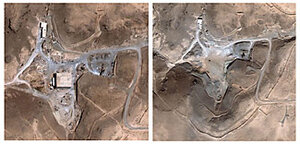With Syria 'reactor' video, U.S. sends a warning
It lets potential nuclear proliferators Iran and North Korea know it's watching.

Airstrike: The US says it has hard evidence that this Syrian plant, bombed by Israel last September, was a nuclear reactor built with help from North Korea.
Washington
US intelligence officials have a message for potential nuclear proliferators: We're watching you, and we see more than you think.
That's the conclusion some experts draw from the US government's unusual April 24 release of evidence that Syria may have been building a nuclear reactor with North Korean assistance.
Israeli warplanes bombed the Syrian site on Sept. 6, 2007. This week, a US delegation is in North Korea pressing the Pyongyang regime for a full accounting of all its nuclear activities, including aid for Syria or any other country.
"This is very striking data to make public. It's clearly intended as a broader message to both the Syrian and North Korean governments," says Anthony Cordesman, a senior military analyst at the Center for Strategic and International Studies in Washington.
It is also possible that the US is sending a warning to Iran, says Mr. Cordesman. If Syria was developing a nuclear-weapons program, it would need fissile fuel for the reactor, a means of processing spent fuel, and design help, as well as the reactor itself.
"There really seem to be only two countries Syria could turn to" for such items, he says. "While everybody is focused on North Korea, Iran is obviously the other."
The evidence given broad distribution in Washington on April 24 is considered by US intelligence to be extremely compelling. It reportedly includes visual confirmation that the core of the Syrian reactor design bears a remarkable resemblance to North Korean's Yongbyon reactor, which itself was copied from old Soviet plans.
A video showing purported North Korean personnel with Syrians inside the site is also part of a presentation US intelligence made to six congressional committees.
The new information "provides dramatic confirmation that the Syrian site ... was a nuclear reactor," concludes an analysis by David Albright and Paul Brannan, researchers at the Institute for Science and International Security (ISIS).
Previous analyses by Mr. Albright had identified the site, approximately 145 kilometers from the Iraqi border along the Euphrates River, as a possible reactor. Prior to its bombing by Israeli warplanes, it contained a large, square building with pumps and other equipment necessary for reactor operation.
Since the bombing, a hill near the site has been bulldozed, and the dirt used to cover the destroyed foundation, according to ISIS. A smaller building with a peaked roof has been built over the site.
But ISIS also notes that the US and Israel have not identified any Syrian plutonium separation or nuclear weaponization facilities.
"The absence of such facilities gives little confidence that the reactor was part of an active nuclear weapons program," says the ISIS analysis.
Syria has refused to allow UN weapons inspectors access to the site, and has denied all reports of a nuclear program. Syrian President Bashar al-Assad has previously said that the Israeli jets targeted empty military buildings.
Mohammad Habbash, a member of Syria's parliament, believes the new allegations are being made to scupper any peace talks between Syria and Israel. Recent reports have suggested that the two nations have resumed a dialogue, with Turkey as a mediator.
In some ways, Israel benefits from the release of the information in Washington: it avoids inflaming Syria further against Israel, yet enhances Israel's deterrence capability.
The revelation of alleged North Korean cooperation comes at a sensitive time for Pyongyang. Under an agreement reached last year, North Korea is required to give a full account of its nuclear activities, including whether it has proliferated nuclear technology. North Korea claims it gave a full declaration to the US in November, but US officials say the North never produced a full and correct declaration.
•Monitor correspondents Joshua Mitnick and Julien Barnes-Dacey contributed from Israel and Germany, respectively. AP material was also used.
